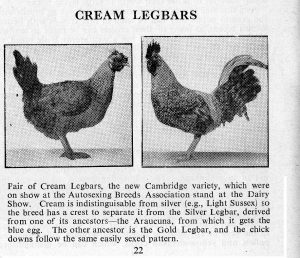
An Introduction to Legbars
The Legbar is a crested, autosexing, light- to medium-weight fowl that carries the blue-egg gene. Legbars are friendly, good foragers and do well avoiding predators in a free range environment, although they can easily adapt to small yards and runs, as well. The unique beauty of the adult male Legbar is one of the things that attracts many to this breed.
Legbar females will sometimes go broody, and they make excellent mother hens. Prolific egg production is a hallmark of a good Legbar. Egg colors vary somewhat among lines and strains, blue is the preferred color and a saturated definite blue is the goal of many who raise this breed.
Please check the club’s status along the path to acceptance for the Cream Legbar by the American Poultry Association.
Early Development
The Cream Legbar was presented at the 1947 London Dairy Show as a new breed of cream colored autosexing chicken, friendly in temperament, and prolific layer of blue eggs. The recessive nature of the cream color, the dominate blue egg color, and the crest which sets this breed apart from its similar Legbar relations was discovered in genetic experimentation performed by Professors R.C. Punnett and Michael Pease.
Professor Punnett received blue egg laying crested Chilean hens from botanist Clarence Elliott in 1929. One of these hens led to Professor Punnett’s monumental discovery of the recessive cream color in poultry in 1931. Professor Punnett experimented with these birds at the University of Cambridge to create crested blue egg layers with the heartiness, production, plumage pattern and type of the Danish Brown Leghorns he used, except with cream replacing the gold coloring.
Later Professor Pease performed his own breeding experiments using Gold Legbars and an inbred UK type White Leghorn from Reaseheath College in Cheshire, England, which also resulted in a number of cream colored birds.
Professors Pease and Punnett bred their cream birds together to see if they had stumbled upon the same cream gene, proving it upon the hatching of all cream offspring. Descendants of these birds were selected for straight single combs, crests, production blue egg laying, and the remarkable autosexing feature that allowed the sexes to be identified at hatch. These qualities were stabilized by 1947, and The Poultry Club of Great Britain adopted a written standard in May, 1958.
Download the Cream Legbar Breed Guide now!